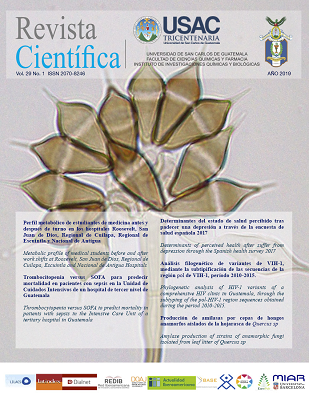Thrombocytopenia versus SOFA to predict mortality in patients with sepsis in the Intensive Care Unit of a tertiary hospital in Guatemala
DOI:
https://doi.org/10.54495/Rev.Cientifica.v29i1.46Keywords:
Organ Dysfunction Scores, Platelet Count, Sepsis, Septic ShockAbstract
The most common coagulation disorder in the intensive care unit is thrombocytopenia. Considering the fundamental role of platelets in hemostasis and as markers of disseminated intravascular coagulation, a significant decrease in platelet counts is alarming in the context of septic patients, and it is known to be a predictor of death. The objective was to compare the ability of the platelet count with the Sequential Organ Failure Assessment (SOFA) to predict death in patients with severe sepsis or septic shock. A longitudinal study was conducted with a sample of 29 consecutive cases evaluated during January to December 2015 in the Intensive Care Unit of the General Hospital of Diseases (HGE) of the Guatemalan Social Security Institute. Platelet and SOFA counts were performed at the first and the fifth day of hospitalization, documenting the outcome of the patients. 51.7% of the patients were men and 48.3% were women, with an average age of 62.0 (16.9) years, median SOFA on admission of 10 units (Q1=4, Q3=14) and platelet median on admission of 196000 (Q1=100000, Q3=250000). The univariate association between thrombocytopenia and death was significant (p = .021, RR = 2.45, CI 95% [1.21, 4.99]). According to a Bootstrap test, there is no significant difference between the predictive capacity of SOFA and platelet count (p = .965). It was concluded that the presence of thrombocytopenia is a simple predictor of death in patients with severe sepsis or septic shock, with similar capacity to SOFA.
Downloads
References
Antier, N., Quenot, J. P., Doise, J. M., Noel, R., Demaistre, E., & Devilliers, H. (2014). Mechanisms and etiologies of thrombocytopenia in the intensive care unit : impact of extensive investigations. Annals of intensive care, 4(1), 24 .https://doi.org/10.1186/s13613-014-0024-x DOI: https://doi.org/10.1186/s13613-014-0024-x
Barton, B., & Peat, J. (2014). Medical Statistics: A Guide to SPSS, data analysis and critical appraisal (2nd ed.). Chichester, West Sussex: John Wiley & Sons.
Boechat, T. de O., Silveria, M. F. B. B. da, Faviere, W., & Macedo, G. L. de. (2012). Trombocitopenia na sepse: um importante marcador prognóstico. Revista brasileira de terapia intensiva 24(1), 35-42. https://doi.org/10.1590/S0103-507X2012000100006 DOI: https://doi.org/10.1590/S0103-507X2012000100006
Dewitte, A., Lepreux, S., Villeneuve, J., Rigothier, C., Combe, C., Ouattara, A., & Ripoche, J. (2017). Blood platelets and sepsis pathophysiology : A new therapeutic prospect in critical ill patients? Annals of intensive care, 7(1), 115. https://doi.org/10.1186/s13613-017-0337-7 DOI: https://doi.org/10.1186/s13613-017-0337-7
Erkurt, M. A., Kaya, E., Berber, I., Koroglu, M., & Kuku, I. (2012). Thrombosytopenia in adults. Journal of Hematology, 1(2-3), 44-53.
Grecco, E., Lupia, E., Bosco, O., Vizio, B., & Montrucchio, G. (2017). Platelets and Multi-Organ Failure in Sepsis. International journal of molecular sciences, 18(10), 2200. https://doi.org/10.3390/ijms18102200 DOI: https://doi.org/10.3390/ijms18102200
Greinacher, A., & Selleng, K. (2010). Thrombocytopenia in the Intensive Care Unit Patient. Hematology, 2010(1), 135-143. https://doi.org/10.1182/asheducation-2010.1.135 DOI: https://doi.org/10.1182/asheducation-2010.1.135
Guclu, E., Durmaz, Y., & Karabay O. (2013). Effect of severe sepsis on platelet count and their indices. African health sciences, 13(2), 333-338. https://doi.org/10.4314/ahs.v13i2.19 DOI: https://doi.org/10.4314/ahs.v13i2.19
Knöbl, P. (2016). Thrombopenie auf der Internsivstation. Medizinische klinik – intensivmedizin und notfallmedizin, 111(5), 425-433. https://doi.org/10.1007/s00063-016-0174-8 DOI: https://doi.org/10.1007/s00063-016-0174-8
Levi, M. (2005). Platelets in sepsis. Hematology, 10(Sepp1), 129-131. https://doi.org/10.1080/10245330512331390177 DOI: https://doi.org/10.1080/10245330512331390177
Marco-Schelke, C. M., Sánchez-Casado, M., Hostigüela-Martín, V. A., Quintana Díaz, M., Rodríguez-Villar, S., Pérez-Pedrero, M. J., … Arrese-Cosculluela. M. Á. (2012). Trombocitopenia grave al ingreso en una unidad de cuidados intensivos en pacientes con disfunción multiorgánica. Medicina intensiva 36(3), 185-192. https://doi.org/10.1016/j.medin.2011.09.011 DOI: https://doi.org/10.1016/j.medin.2011.09.011
Minne, L., Abu-Hanna, A., & de Jonge, E. (2008). Evaluation of SOFA-based models for predicting mortality in the ICU: A systematic review. Critical care, 12(6), R161. https://doi.org/10.1186/cc7160 DOI: https://doi.org/10.1186/cc7160
Mukaka, M. M. (2012). Statistics corner: A guide to appropriate use of correlation coefficient in medical research. Malawi medical journal, 24(3), 69-71.
Rhodes, A., Evans, L. E., Alhazzani, W., Levy, M. M., antonelli, M., Ferrer, R., … Dellinger, R. P. (2017). Surviving Sepsis Campaign. Critical care medicine, 45(3), 486-552. https://doi.org/10.1097/CCM.0000000000002255 DOI: https://doi.org/10.1097/CCM.0000000000002255
Smock, K. J., & Perkins, S. L. (2014). Thrombocytopenia: an update. International journal of laboratory hematology, 36(3), 269-278. https://doi.org/10.1111/ijlh.12214 DOI: https://doi.org/10.1111/ijlh.12214
Downloads
Published
How to Cite
Issue
Section
License
Copyright (c) 2019 Nancy Escobar Jímenez, Jorge Ranero Meneses, André Chocó-Cedillos

This work is licensed under a Creative Commons Attribution 4.0 International License.
Authors who publish with this journal agree to the following terms:
- Authors retain copyright and grant the journal right of first publication with the work simultaneously licensed under a Creative Commons Attribution License 4.0 that allows others to share the work with an acknowledgement of the work's authorship and initial publication in this journal.
- Authors are able to enter into separate, additional contractual arrangements for the non-exclusive distribution of the journal's published version of the work (e.g., post it to an institutional repository or publish it in a book), with an acknowledgement of its initial publication in this journal.
- Authors are permitted and encouraged to post their work online (e.g., in institutional repositories or on their website) prior to and during the submission process, as it can lead to productive exchanges, as well as earlier and greater citation of published work.









